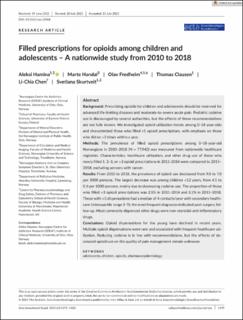Filled prescriptions for opioids among children and adolescents – a nationwide study from 2010 to 2018
Hamina, Aleksi; Handal, Marte; Fredheim, Olav Magnus; Clausen, Thomas; Chen, Li-Chia; Skurtveit, Svetlana Ondrasova
Peer reviewed, Journal article
Published version
Permanent lenke
https://hdl.handle.net/11250/3009397Utgivelsesdato
2021Metadata
Vis full innførselSamlinger
- Artikler [5061]
- Publikasjoner fra CRIStin FHI [7531]
Originalversjon
10.1111/aas.13968Sammendrag
Background Prescribing opioids for children and adolescents should be reserved for advanced life-limiting diseases and moderate-to-severe acute pain. Pediatric codeine use is discouraged by several authorities, but the effects of these recommendations are not fully known. We investigated opioid utilization trends among 0–18-year-olds and characterized those who filled ≥1 opioid prescriptions, with emphasis on those who did so >3 times within a year. Methods The prevalence of filled opioid prescriptions among 0–18-year-old Norwegians in 2010–2018 (N = 77,942) was measured from nationwide healthcare registries. Characteristics, healthcare utilization, and other drug use of those who newly filled 1, 2–3, or >3 opioid prescriptions in 2011–2014 were compared to 2015–2018, excluding persons with cancer. Results From 2010 to 2018, the prevalence of opioid use decreased from 9.0 to 7.0 per 1000 persons. The largest decrease was among children <12 years, from 4.1 to 0.4 per 1000 persons, mainly due to decreasing codeine use. The proportion of those who filled >3 opioid prescriptions was 2.1% in 2011–2014 and 3.1% in 2015–2018. Those with >3 dispensations had a median of 4 contacts/year with secondary healthcare (interquartile range 2–7); the most frequent diagnoses indicated post-surgery follow-up. Most commonly dispensed other drugs were non-steroidal anti-inflammatory drugs. Conclusions Opioid dispensations for the young have declined in recent years. Multiple opioid dispensations were rare and associated with frequent healthcare utilization. Reducing codeine is in line with recommendations, but the effects of decreased opioid use on the quality of pain management remain unknown.
